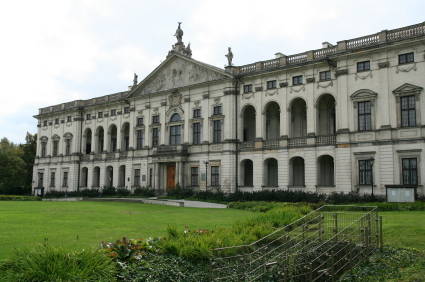Must-See Warsaw Sights
Lazienki Palace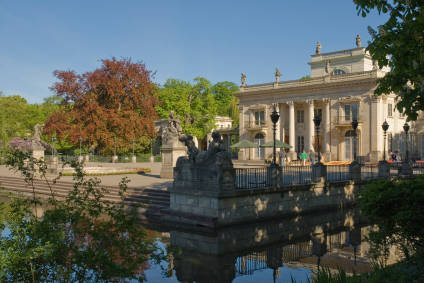
Lazienki Park and Palace are both beautiful and relaxing sights to see. Lazienki Park and Palace are both beautiful and
relaxing sights to see. The palace, known as "The Palace on the Isle" is built on a lake and is accessible by foot bridges. Wander the park or enter the palace depending upon your mood and the weather. The park offers pathways and shady benches, while the palace allows visitors a glimpse into the life of its previous inhabitants.
|
Chopin Monument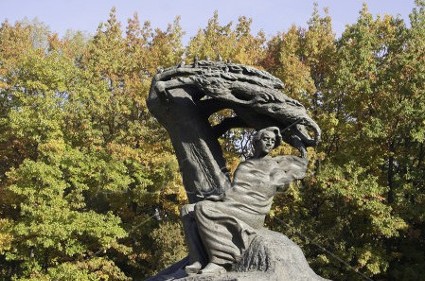
Warsaw is the birthplace of the famous Polish composer, Chopin. The Chopin Monument, located in Lazienki Park, is often used as a meeting place for music lovers and a venue for concerts. The original version of this monument is no longer in existence; its reproduction was created after Nazis destroyed the 1926 monument.
|
Royal Castle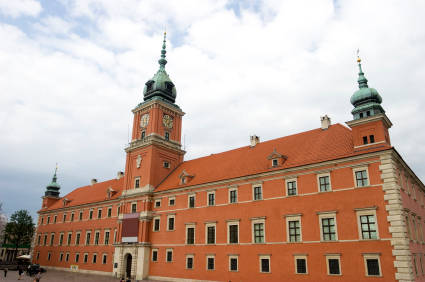
When taking a tour of the Royal Castle in Warsaw, be mindful that this structure is a reproduction of the original, just like the Chopin Monument. And, like the composer's monument, the original Royal Castle was destroyed by Nazis during WWII. While the exterior has been recreated, the interior of the Royal Castle is surprisingly authentic. Furniture that was saved from destruction, or replacements from the same period, serve to illustrate the uses of the castle's rooms.
|
Castle Square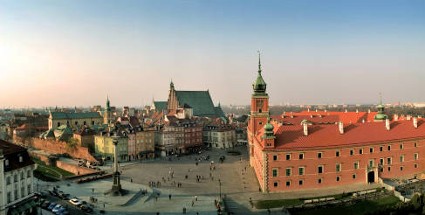
The Royal Castle overlooks Castle Square in Warsaw. This grand square is used for speeches, gatherings, and entertainment. Warsaw also has other squares of note, like the Old Town Market Square and the New Town Market Square. Warsaw's squares are great places to have a snack or a drink and experience the city.
|
Palace of Science & Culture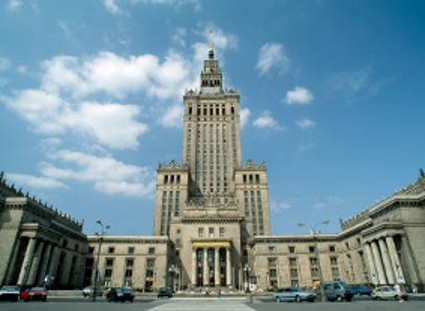
Palace of Science and Culture was Stalin's gift to Poland. Its monstrous form and looming silhouette are characteristic of the architectural style favored by the Soviets. The Palace of Science and Culture is a multi-purpose building that now rents commercial space to businesses. Today, it is famous mostly for its impressive size and even more impressive ugliness.
|
National Library of Poland
|
The Heroes of the Ghetto
Near the Palace of Science and Culture is the location of the former Warsaw Ghetto. The sight of the Warsaw Ghetto Uprising, the Warsaw Ghetto was destroyed in the 1940's and its inhabitants murdered or sent to concentration camps. This memorial, as well as the nearby Umschlagplatz Memorial, remember the victims of the Warsaw Ghetto as well as those who tried to fight back against the Nazis' actions.
|
Warsaw Barbican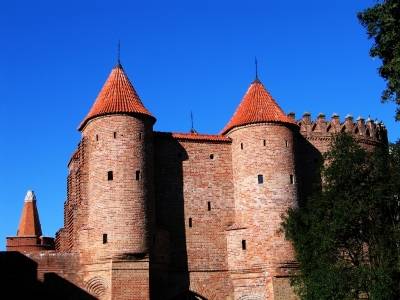
The Warsaw Barbican was a defensive structure that was initially built to replace one of the gates of the walled city of Warsaw. Like many of Warsaw's buildings, the Barbican has been reconstructed, but this doesn't make the structure any less impressive.
|
Wilanow Palace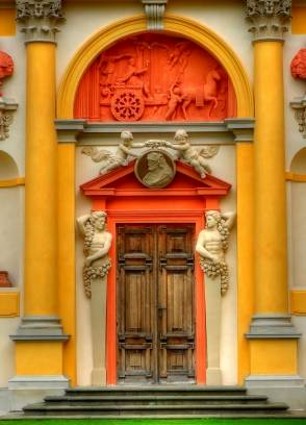
The Wilanow Palace in Warsaw is now a museum that showcases its many owners' eclectic style preferences and additions. The architecture of the Wilanow Palace, portrait galleries, and other museum exhibits make for an interesting afternoon. If you aren't into museum-going, stroll the palace grounds.
|
Zygmunt's Column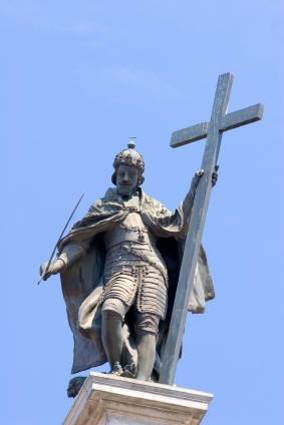
Zymunt's Column, erected to commemorate a 17th century Polish king, is an original monument, though it did have to be repaired after the Nazi invasion. Zygmunt's Column is located in Castle Square and marks the beginning of Warsaw's Royal Route. Visitors can follow this route to see some of Warsaw's most historic and beautiful architecture.
|
Warsaw is older than it looks: the first settlements in the area stretch back to the 10th century and the first records back to the 11th. Around the middle of the 11th, someone thought it noteworthy to report an ominous event for a city later razed again and again: a wooden fort belonging to the Mazowiecki Princes was burned in Jazdow during a Lithuanian-Russian raid. The fort was burned again in 1281 and most likely never rebuilt. But north of Jazdow, they built a better replacement at the end of the 13th century on the site where today stands the Royal Castle of Warsaw. Enclosed in protective walls, the Mazovian Princes claimed this area as their seat of power in 1413, and what is now known as Warsaw began to grow.
But the neutral Mazovian princedom did not remain so for long. In 1526, when the Mazowiecki line failed to produce heirs, the entire Mazowsze region, including Warsaw, was incorporated into the Polish crown. Still, Warsaw remained a political backwater until Poland and Lithuanian unified in 1569. It was an issue of geographical convenience: Warsaw was closer to the Lithuanian capital of Vilnius. Only 4 short years later, the kings were being elected here, and 27 years after the unification King Zygmunt III Waza moved the capital from Krakow to Warsaw. Some claim he moved due to the burning of Wawel Castle in Krakow, but others note how much closer Warsaw was to Zygmunt's home country of Sweden.
Despite this royal closeness, Warsaw was soon to suffer terribly from the Swedes. Between 1655 and 1658, Warsaw was thrice besieged and entirely plundered by the Swedish and Siedmiogrodzkie forces. Years later Henryk Sienkiewicz eloquently described these years, known as "The Deluge", in his Trilogy. Warsaw rallied following the election of King Jan III Sobieski, but continued internal ferment and yet another invasion by the Swedish King Charles XII kept Warsaw destabilized for most of the 18th century as well. But before the century ended, the rule of the Saski Family stabilized the political situation and Warsaw again became an important center of culture, education, and enlightenment.
This period, led by King Stanislaw August Poniatowski, was later coined as Warsaw's second "golden era" when it was transformed into a modern city. Crowning these architectural achievements, the first European, democratic constitution (second only to that of the US) was declared on May 3, 1791.
Ironically, at this same time, Poland's ongoing partitions limited the freedom of the city. In 1794, Varsovians joined the heroic, albeit unsuccessful, Kosciuszko Uprising by attacking Russian troops stationed in the capital. While initially a success, the uprising was eventually squashed and Warsaw along with a large part of Mazowsze region was incorporated into Prussia in 1795. Warsaw had a brief respite in 1807 when Napoleon established a Duchy of Warsaw, but this ended in 1830 when the Russians took control until WWI began.
When Poland regained its independence in 1918, Varsovians worked energetically to revamp and expand the city and its infrastructure. But war put an end to that. Germany invaded Poland on the 1st of September, 1939 and for 28 days the Poles resisted, but Warsaw fell despite their heroic efforts. Such resistance continued throughout the war, marked notably by two uprisings in 1943 and 1944.
In April of 1943, the Jewish Ghetto Uprising erupted and lasted for one month of intense fighting before the German army managed to overcome the area and liquidate the ghetto, and along with it the centuries old population. The following year, the Warsaw Uprising began in the hopes of liberating the city from the Germans, but the Soviet army - camped across the Vistula - did not help and after 63 days of bitter house-to-house fighting the attempt to liberate the city failed. Following the Uprising, Hitler ordered Warsaw destroyed; consequently 85% of the city was reduced to rubble over the following 3 months. Only in January of the next year did the Soviet army finally cross the river to enter the decimated city.
After WWII ended, Warsaw was rebuilt. The Royal Castle and the surrounding Old Town were painstakingly reconstructed from pictures rendered in the 17th and 18th centuries. Unfortunately, construction in the rest of the city was not based on the past, and 'real socialism' survives today in the myriad blocks and bunkers of modern day Warsaw. In 1989, Poland again became a democracy and today thrives as never before. One hopes it has entered its third 'golden age'.
